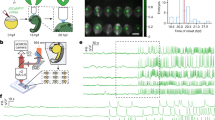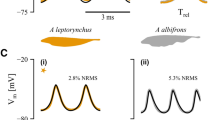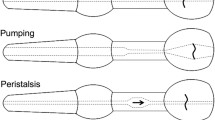Summary
The ampullae of Molgula occidentalis are hollow, tubular extensions of the epidermis. They are ensheathed by a secreted tunic. When they grow out shortly after settlement, the ampullae spread the tunic over the substratum to form a firm attachment for the sessile juvenile. A simple squamous epithelium forms the thin ampullar walls. A glandular, simple columnar epithelium forms the distal tip of each ampulla. The glandular cells probably secrete the adhesive that attaches the tunic to the substratum.
Repetitive, peristaltic contractions pass from the base to the distal end of each ampulla. Microsurgery, time-lapse cinemicrography and TEM have been used to analyze this phenomenon. The contractions are mediated by a layer of 4–8 nm microfilaments in the base of the ampullar epithelium.
Each juvenile has 7–9 ampullae which contract at different frequencies. Isolated ampullae continue to contract normally for several days. Thus each ampulla has an intrinsic rhythm. Microsurgical experiments suggest that there is no specific region within an ampulla with unique pacemaker properties. It is proposed that communication via gap junctions allows the coordination of ampullar cells into a well organized peristaltic wave.
Similar content being viewed by others
References
Abbott DP (1953) Asexual reproduction in the colonial ascidian Metandrocarpa taylori Huntsman. U Calif Publ Zool 61:1–78
Abbott DP (1955) Larval structure and activity in the ascidian Metandrocarpa taylori. J Morphol 97:569–594
Bancroft FW (1899) A new function of the vascular ampullae in the Botryllidae. Zool Anz 22:450–462
Berrill NJ (1929) Studies in tunicate development. Part I. General physiology of development of simple ascidians. Phil Trans Roy Soc 218B:37–78
Berrill NJ (1931) Studies in tunicate development II. Abbreviation of development in the Molgulidae. Phil Trans Roy Soc 219B:281–346
Berrill NJ (1949) The gonads, larvae and budding of the polystyelid ascidians Stolonica and Distomus. J Mar Biol Ass UK 28:633–650
Berrill NJ (1950) The Tunicata with an account of the British species. Ray Society, London
Bone Q, Mackie GO (1975) Skin impulses and locomotion in Oikopleura (Tunicata: Larvacea). Biol Bull 149:267–286
Brewin BI (1959) An account of larval budding in the compound ascidian Hypsistozoa fasmeriana. Quart J Microsc Sci 100:575–589
Carlisle DB (1961) Locomotory powers of adult ascidians. Proc Zool Soc London 136:141–146
Cloney RA (1966) Cytoplasmic filaments and cell movements: Epidermal cells during ascidian metamorphosis. J Ultrastr Res 14:300–328
Cloney RA (1969) Cytoplasmic filaments and morphogenesis: The role of the notochord in ascidian metamorphosis. Z Zellforsch 100:31–53
Cloney RA (1972) Cytoplasmic filaments and morphogenesis: Effects of Cytochalasin-B on contractile epidermal cells. Z Zellforsch 132:167–192
Cloney RA (1978) Ascidian metamorphosis: Review and analysis. In: Chia F-S, Rice M (eds) Settlement and metamorphosis in marine invertebrate larvae. Elsevier-New York, New York Oxford, pp 255–282
Cloney RA, Florey E (1968) Ultrastructure of cephalopod chromatophre organs. Z Zellforsch 89: 250–280
Deck JD, Hay ED, Revel J-P (1966) Fine structure and origin of the tunic of Perophora viridis. J Morphol 120:267–280
DeLeo G, Patricolo E, D'Ancona Lunetta G (1977) Studies on the fibrous components of the test of Ciona intestinalis L. I. Cellulose-like polysaccharide. Acta Zool (Stockh) 58:135–141
DeSanto RS, Dudley PL (1969) Ultramicroscopic filaments in the ascidian Botryllus schlosseri (Pallas) and their possible role in ampullar contractions. J Ultrastr Res 28:259–274
Dilly PN (1969) The ultrastructure of the test of the tadpole larva of Ciona intestinalis. Z Zellforsch 95:331–346
Endean R (1955) Studies of the blood and tests of some Australian ascidians. III. The formation of the test of Pyura stolonifera (Heller). Austr J Mar Freshw Res 6:157–164
Endean R (1961) The test of the ascidian Phallusia mammillata. Quart J Microsc Sci 102:107–117
Faulkner GT (1970) Formation and fine structure of the larval tunic in simple ascidians. PhD thesis, U of Wisconsin
Georges D (1979) Gap and tight junctions in tunicates. Study in conventional and freeze-fracture techniques. Tiss & Cell 11:781–792
Grave C (1926) Molgula citrina (Alder and Hancock). Activities and structure of the free-swimming larva. J Morphol 42:453–467
Katow H, Watanabe H (1978) Fine structure and possible role of ampullae on tunic supply and attachment in a compound ascidian, Botryllus primigenus Oka. J Ultrastr Res 64:23–34
Korn ED (1978) Biochemistry of actomyosin-dependent cell motility (A review). Proc Natl Acad Sci USA 75:588–599
Lash JW, Cloney RA, Minor RR (1973) The effect of Cytochalasin-B upon tail resorption and metamorphosis in ten species of ascidians. Biol Bull 145:360–372
Luft JH (1961) Improvements in epoxy resin embedding methods. J Biophys Biochem Cytol 9:409–414
Mackie GO, Bone Q (1976) Skin impulses and locomotion in an ascidian tadpole. J Mar Biol Ass UK 56:751–768
Mackie GO, Bone Q (1977) Locomotion and propagated skin impulses in salps (Tunicata: Thaliacea). Biol Bull 153:180–197
Millar RH (1951) The stolonic vessels of the Didemnidae. Quart J Microsc Sci 92:249–254
Mukai H, Sugimoto K, Taneda Y (1978) Comparative studies on the circulatory system of the compound ascidians Botryllus, Botrylloides and Symplegma. J Morphol 157:49–77
Newberry AT (1965a) Vascular structures associated with budding in the polystyelid ascidian Metandrocarpa taylori. Ann Soc Roy Zool Belg 95:57–74
Newberry AT (1965b) The structure of the circulatory apparatus of the test and its role in budding in the polystyelid ascidian Metandrocarpa taylori Huntsman. Mem Acad Roy Belg, Cl Sci sect 2 16:1–57
Scott FM (1952) The developmental history of Amaroucium constellatum. III. Metamorphosis. Biol Bull 103:226–241
Sebastian VO (1953) The development of Herdmania pallida (Heller). Proc Ind Acad Sci 37:174–187
Smith MJ (1970) The blood cells and tunic of the ascidian Halocynthia aurantium (Pallas). II. Histochemistry of the blood cells and tunic. Biol Bull 138:379–388
Staehelin LA (1974) Structure and function of intercellular junctions. Intern Rev Cytol 39:191–284
Terakado K (1970) Tunic formation in the larva of the ascidian Perophora orientalis. Sci Rep Saitama Univ (B) 5:183–191
Trason WB (1957) Larval structure and development of the oozooid in the ascidian Euherdmania claviformis. J Morphol 100:509–546
Wardrop AB (1970) The structure and formation of the test of Pyura stolonifera. Protoplasma 70:73–86
Willey A (1900) On the protostigmata of Molgula manhattensis (DeKay). Quart J Microsc Sci 44:141–159
Author information
Authors and Affiliations
Rights and permissions
About this article
Cite this article
Torrence, S.A., Cloney, R.A. Rhythmic contractions of the ampullar epidermis during metamorphosis of the ascidian Molgula occidentalis . Cell Tissue Res. 216, 293–312 (1981). https://doi.org/10.1007/BF00233621
Accepted:
Issue Date:
DOI: https://doi.org/10.1007/BF00233621




